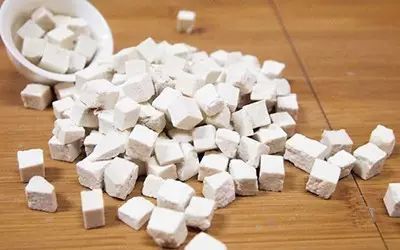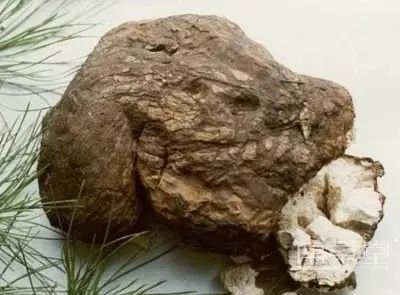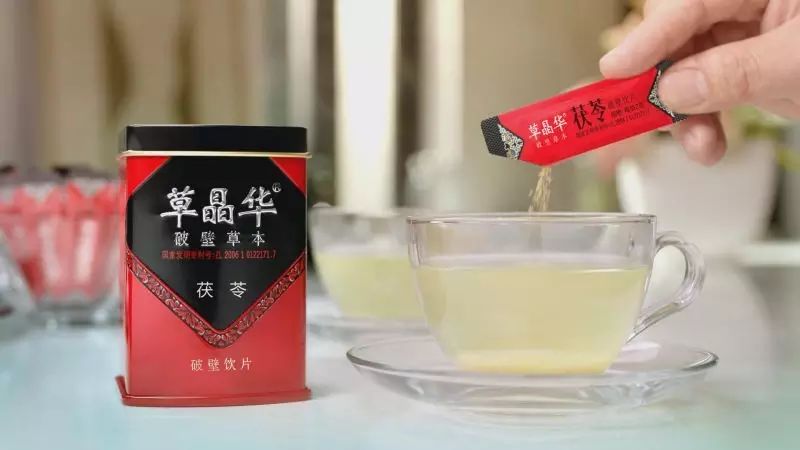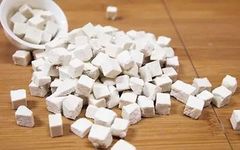
Compiled by Zhao Anqi
Returning from the grass hall, the smoke and clouds linger, the yellow sash hangs low, what can be done?
Because you seek medicine in Huayang, beneath the green pines, Fu Ling is abundant.
This poem by Li Shangyin tells us about the harvesting location of Fu Ling (Poria) — it grows on the roots of trees such as red pine or masson pine, and is a type of fungus. The medicinal part is the dried sclerotium, mainly produced in Yunnan, Anhui, Hubei, Henan, and Sichuan. Those from Yunnan are called “Yun Ling,” which are of superior quality.
Fu Ling is neutral in nature and flavor, used both as food and medicine. When processed into powder, it can be made into Fu Ling buns, Fu Ling wontons, Fu Ling pancakes, etc., which are famous local foods.
Draining Dampness and Promoting Urination
Fu Ling has a sweet and bland taste, and is neutral in nature. In TCM, we often talk about the five flavors: sour, bitter, sweet, spicy, and salty, but there is no bland flavor. So where does the blandness come from? Traditional Chinese Medicine (TCM) believes that blandness is a residual flavor of sweetness. Fu Ling is actually tasteless, which is referred to as “bland.” The reason for adding “sweet” in front is due to the traditional pairing of sweet and bland, essentially categorizing blandness into the five flavors.
We know that each of the five flavors in TCM corresponds to specific functions. What does blandness correspond to? Blandness can drain and promote. While both drain dampness and promote urination, draining is more gradual, while promoting is more immediate. One gathers the dispersed dampness and expels it, while the other directly eliminates water dampness. Overall, the ability to drain and promote indicates a diuretic effect.
Fu Ling grows on decayed pine tree roots, and some roots pass through the center of Fu Ling, which is called “embracing wood.” The part that encases the root is referred to as “Fu Shen,” believed to have a stronger calming effect. In ancient literature, the character “Fu” can be written without the grass radical, directly as “伏” (to hide), and “Ling” is written as “灵” (spirit), because the ancients believed that pines have a spiritual essence. After the pine tree dies, this essence settles in the roots, hence the name “Fu Ling.”
Textbooks state that Fu Ling is a key herb for draining dampness and promoting urination. Why is this so? There are two main reasons. First, Fu Ling has a significant diuretic and damp-draining effect, and its neutral nature means it can be used for both cold and heat conditions without preference. Second, it is suitable for both deficiency and excess. In dampness conditions, whether deficiency or excess, Fu Ling can be used because it primarily drains dampness and expels pathogenic dampness while also tonifying the spleen and supporting the righteous Qi, thus expelling pathogens without harming the righteous Qi, and supporting the righteous Qi without obstructing the pathogens.

Somewhat Strengthening the Spleen
As mentioned above, Fu Ling expels pathogens without harming the righteous Qi, which is due to its ability to strengthen the spleen. In the sixtieth chapter of Dream of the Red Chamber, it mentions Fu Ling cream “mixed with human milk, taken every morning, is very nourishing.” This refers to the spleen-strengthening effect of Fu Ling. (Fu Ling cream is made from fresh Fu Ling, peeled, ground into a paste, and dried into a fine white powder, hence the name.)
Compared to Bai Zhu (Atractylodes macrocephala) and Cang Zhu (Atractylodes lancea), Fu Ling’s spleen-strengthening effect is not strong, but it is a commonly used auxiliary herb for treating spleen deficiency. Why? Because the spleen governs transportation and transformation, and spleen deficiency often leads to weak transportation, which can easily generate dampness. This means that when the spleen is deficient, there is often internal dampness. At this time, it is necessary to both tonify the deficiency and eliminate the existing dampness. Fu Ling is a suitable auxiliary herb that can be used in combination with herbs such as Ren Shen (Ginseng), Shan Yao (Chinese Yam), Huang Qi (Astragalus), and Dang Shen (Codonopsis) to tonify spleen Qi.
Also Calming the Mind and Spirit
The third effect of Fu Ling is calming the mind and spirit, which can treat symptoms of restlessness, generally manifested as palpitations, insomnia, and forgetfulness. For those with restlessness, Fu Ling is suitable for both deficiency and excess conditions, and can be used in combination with herbs that tonify heart Qi and nourish heart blood to treat deficiency conditions. For excess conditions, such as blood stasis, phlegm obstruction, and phlegm dampness disturbing the mind, Fu Ling can also be used, as it does not interfere with expelling pathogens.
There are two types of Fu Ling: Chi Fu Ling (Red Poria) and Bai Fu Ling (White Poria), both having similar effects. Traditional herbal texts generally state that the red type enters the heart, while the white type enters the lungs. For example, the Compendium of Materia Medica states that Fu Ling “is formed from the spiritual essence of pine roots… the white type enters the lungs and bladder Qi level; the red type enters the heart and small intestine Qi level.”

Fu Ling has a gray-brown outer layer, known as Fu Ling Pi (Poria Skin), which specifically promotes water metabolism and can treat skin edema, which is skin swelling. This aligns with the TCM principle of taking symbols and analogies, as stated in the Compendium of Materia Medica, “using the skin to act on the skin.”
In the past, there was a special processing method called “Zhu Sha Ban Fu Ling” (Cinnabar Mixed Poria), which involved grinding cinnabar into a fine powder and dyeing it on the surface of Fu Ling, making it look beautiful with a white and red appearance. However, it is now generally considered an unreasonable processing method. Cinnabar is not water-soluble and does not enter decoctions, but this processed “Zhu Fu Ling” is ultimately meant to be used in decoctions, where cinnabar cannot exert its effects due to its insolubility. Additionally, this cinnabar often quickly falls off in decoctions, as its density is high and it quickly settles at the bottom of the pot, where the temperature is highest, potentially leading to decomposition into sulfur dioxide and mercury, posing a risk of poisoning.
Regarding the use of Fu Ling, there are two points to note. First, when used in decoctions, it is best to cut it into thin slices. Renowned physician Zhang Xichun from the Republic of China stated: “If Fu Ling is used in decoctions, it must be cut into thin slices; otherwise, if cut into chunks, it will not be fully cooked even after a whole day of boiling. It must be sliced thinly or ground into powder to ensure thorough cooking.” Chengdu University of Traditional Chinese Medicine’s Zhang Tingmo also shares this view, pointing out that Fu Ling can be quite large, weighing several kilograms or more than ten kilograms. If cut into 1 cubic centimeter cubes and boiled for an hour, the center will still be dry, while if cut into 2 millimeter thick slices, it may be fully cooked in half an hour. In this regard, the recently popular large-scale TCM cultural documentary “Bencao China” introduces “Cao Jinghua • Broken Wall Herbs,” which may be helpful. Zhang Xichun’s mention of “grinding into powder” is actually a method of decoction — “cooking scattered,” which involves crushing the herbs and then boiling them in water. Due to the higher solubility after crushing, cooking scattered herbs generally saves a lot of material compared to regular slices. Nowadays, “Cao Jinghua • Broken Wall Herbs” utilizes wall-breaking technology (which breaks the plant cell walls to enhance the absorption and utilization of the active ingredients), further improving the solubility in decoction while retaining the full components of the herbs, combining convenience, economy, and effectiveness, characterized by “better absorption and ease of use.”
Second, although Fu Ling is used both as food and medicine, Republican-era TCM educator Peng Ziyi believed that “all damp-draining substances harm body fluids.” Jin dynasty physician Li Dongyuan also noted that Fu Ling “if taken by those who sweat a lot, harms the original Qi and shortens life,” thus it is generally believed that those with Yin deficiency or excessive sweating should avoid consuming Fu Ling in large amounts.



